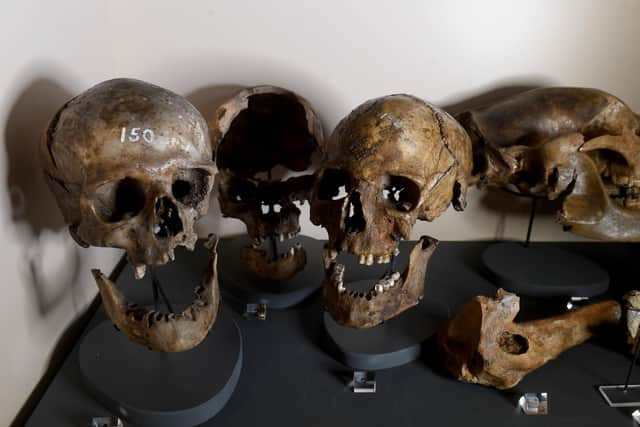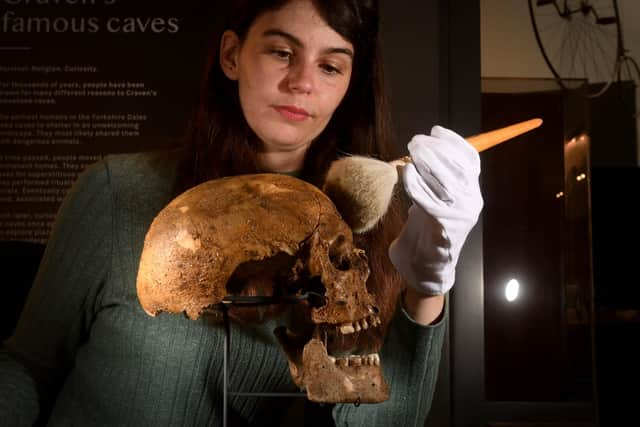Ancient skulls discovered in Yorkshire Dales cave date back to ritual burials over 5,000 years ago
Remains were first found at Elbolton Cave in the late 1880s, with further excavations in 1920 suggesting the burials of at least 11 people, as well as shards of pottery and bowls.
The findings were thought to be from the Bronze Age but now, with new scientific dating, it emerges they date back to the early Neolithic period.
Advertisement
Hide AdAdvertisement
Hide AdWhat it means, said Jenny Hill of the Craven Museum, is that people have lived in the area for far longer than first thought.


It's proof of human existence for over 5,000 years.
Ms Hill said: "It's very important, these finds. It's shows that humans have been living in the Craven area since the Neolithic period.
"It shows us how they lived - they were using these caves.
"We don't know for what purpose, or if it was a burial place," she added.


"They were placed in the cave in an unusual position, so they were placed there purposefully.
Advertisement
Hide AdAdvertisement
Hide Ad"It's really exciting to see now that people have been living here for so long. Even when we thought these finds were from the Bronze Age, it was a huge amount of human history."
It was the Revd E Jones of Embsay who first made the archaeological discoveries back in 1888, and there were further excavations of the Elbolton Cave, on private land near Grassington, in 1920.
Finds included animal and human bones, with some in an unusual crouched burial.
In 1973 it was estimated they were from the Early Bronze Age, but doubt was thrown on these findings back in 2013 when assessments speculated they may actually be older.
Advertisement
Hide AdAdvertisement
Hide AdUnder the Yorkshire Archaeological & Historical Society's Dates in Drawers project, this has now been proven.
For many years, three bodies which were excavated in 1889 have been in the care of Craven Museum at Skipton Town Hall.
They were found in crouched burials, interred in crude stone cists, and with some possible evidence of excarnation: they had been allowed to be partly eaten by wolves or foxes before being buried.
Scientific dating of one of the skulls now shows that it dates from between 3947 to 3764 BC.
Advertisement
Hide AdAdvertisement
Hide AdThe scientific study was carried out by the Radiocarbon Laboratory at Glasgow's Scottish Universities Environmental Research Centre (SUERC).
While two skulls were submitted for tests, they had been heavily coated in wax in the past to preserve them.
Although the wax could not be removed, it proved possible to remove a single tooth from one of them and test the unexposed root.
The new dates are of significant interest because of the evidence of ritual suggested in their burial, experts have said. It also adds to understanding of the prehistory of this corner of the Yorkshire Dales.
Advertisement
Hide AdAdvertisement
Hide AdOne of the purposes of founding the Craven Museum in 1928 was to house the finds from the Elbolton Cave excavations, together with the Craven Herbarium and other pieces.
Ms Hill, museum lead, said: "They are so significant, and have always had this mystery surrounding their date.
"It really helps understanding to see how old the history of the people of the area is. It helps us to know how long-standing that history is.
"I've seen it myself, when children come in. If you can 'this is from the Stone Age' or 'Neolithic times', it makes it so much clearer to them."
Advertisement
Hide AdAdvertisement
Hide AdDavid Asquith, president of the Yorkshire Archaeological & Historical Society, was delighted with the Dates in Drawers findings.
He said: "I think this shows what local initiative and targeted support can do.
"Thanks to Jenny's enthusiasm the society is building a great partnership with Craven Museum and we look forward to similar productive projects with other Yorkshire museums."
The skulls are on permanent display at Craven Museum, Skipton Town Hall, alongside other items discovered in the cave. Entry to the museum is free.